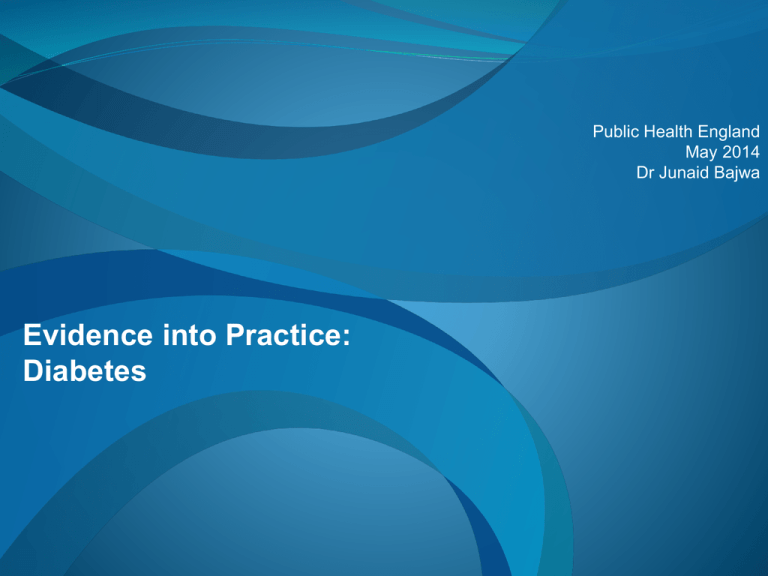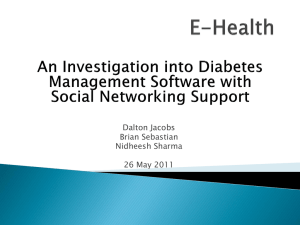
Public Health England
May 2014
Dr Junaid Bajwa
Evidence into Practice:
Diabetes
About me
GP, CCG Board Member NHS Greenwich
Primary Care Transformation Board Member, NHSEL
Associate in Public Health, NHS Greenwich
Council Member of the Clinical Senate, London
GP Appraiser NHSE
Programme Director, Greenwich VTS
Prepare to Lead alumni, NHS London
Value Based Healthcare Alumni, Harvard Business School
What motivated us?
Life Expectancy at birth Greenwich and England 1996-1998 and 2007-2009
NHS Greenwich was one of 13 PCTs identified by the National Health Inequalities Support
Team that account for 40% of the National Gap in life expectancy
The impact of improved CVD prevention on
life expectancy
CVD Health Checks includes the impact of schemes to improve Long Term Conditions
management and the NHS Health Checks Programme
Diabetes in Greenwich
Diabetes is a major cause health inequalities
Priority disease area for Greenwich in the JSNA
2010
10,033 patients with diabetes recorded.
YHPHO prevalence model estimates it should be 12,900
Suggesting more than 22% of patients with
diabetes in Greenwich are undiagnosed¹
YHPHO prevalence model estimates by 2020 there
will be an estimated Increase of 37%.¹
1 – YHPHO prevalence model for England
NHS Greenwich
GOAL 2 – A systematic approach
A systematic approach to primary and secondary prevention in primary
and community care
This includes ensuring that service provision and quality is consistent
across Greenwich
To ensure robust easy referral relationships between primary care
teams and primary prevention services e.g. GHLiS
To help improve the skills and confidence of primary care practitioners
– through appropriate investment
Cultural shift towards a proactive approach to prevention through
routine and opportunistic screening approaches in practices and other
settings
Data provided by Greenwich PCT’s from Greenwich commissioning strategy for the 5 years 2008/09 – 2012/13 – Pg34
EVIDENCE into PRACTICE™
Delivered as a free of charge pilot across 14 practices
in Greenwich.
Practices selected using health inequalities markers.
How did we start? Who was involved? What
happened?
EiP Process and Tools
EIP.12.GB.100102.SL
Date of Preparation March 2012
What did we achieve? What change was there for
patients?
Greenwich PCT Amalgamated Data: Number of Patients Achieving NICE Endorsed* Risk Factor
Targets at Baseline and Follow-Up
*Risk Factor Targets Based on NICE Type 2 Diabetes Guidelines, CG87, May 2009
Data on File MSD, September 2011
Date of Preparation September 2011
Data on File NHS Greenwich, September 2011
Impact of the EVIDENCE into PRACTICE™ programme on Diabetic 25 Medicine Outpatient
attendances and CVD admissions in NHS Greenwich pilot sites (14) compared to non pilot
sites (32). Figures standardised per 1000 patients with diabetes.
Data on File NHS Greenwich, September 2011
Impact of the EVIDENCE into PRACTICE™ programme on Diabetic 25 Medicine Outpatient
attendances and CVD admissions in NHS Greenwich pilot sites (14) compared to non pilot
sites (32). Figures standardised per 1000 patients with diabetes.
Data on File NHS Greenwich, September 2011
Impact of the EVIDENCE into PRACTICE™ programme on Diabetic 25 Medicine Outpatient
attendances and CVD admissions in NHS Greenwich pilot sites (14) compared to non pilot
sites (32). Figures standardised per 1000 patients with diabetes.
Data on File NHS Greenwich, September 2011
Who did what in the practice? How did we change?
What roles did different people in the practice take to
make the change happen? What were the key changes?
Background
Failing Practice, poor performance
Deprived local area, within spearhead PCT
Large BME population
High incidence of Diabetes and CVD- not on risk registers
or being optimally managed
Practice Transformation
Case for change
Key focus areas (DCiP/Patient list file)
Data Quality
Risk Registers
Ensuring patients on current registers are being optimally
treated/managed/ have the right support
Personal/Practice Development issues: clinical exercises
Confidence mapping of existing skill mix within practice
Critical event review exercise
What we did
Clear diabetes management strategy
roles/responsibilities
Addressed training in issues (Evidence Review)
Ensuring consistent treatment approach
(HbA1c, BP, Cholesterol targets)
Stratifying cardio-metabolic risk in the population
focus on optimising treatment in existing patients
All diabetics
Baseline Vs 3rd Repeat Follow-Up data for Conway Medical Centre
Time between data extractions = 18 Months 6 Days
Risk Factor targets Based on NICE CG87, May 2009.
Data on File MSD, September 2011
Date of Preparation September 2011
Data on File MSD, September 2011
What impact did the EiP approach to diabetes have on
the whole practice population health otucomes?
The UKPDS Outcomes Model
• Computerised simulation designed to estimate Life Expectancy, Quality Adjusted Life
Expectancy and costs of complications in people with type 2 diabetes.
• Uses algorithms published in the UK Prospective Diabetes Study (UKPDS).
• The model was developed using data from patients with newly-diagnosed type 2
diabetes who participated in the UKPDS 2 and were followed up for between six and
twenty years.
• It predicts likely outcomes using risk factors that include; age, sex, ethnicity, duration of
diabetes, height, weight, smoking status, total cholesterol, HDL cholesterol, systolic
blood pressure and HbA1c.
• The UKPDS Outcomes Model is able to simulate event histories that closely match
observed outcomes in the UKPDS and that can be extrapolated over patients’ lifetimes.
The model allows simulation of a range of long-term outcomes, which should assist in
informing future economic evaluations of interventions in Type 2 diabetes
A model to estimate the lifetime health outcomes of patients with Type 2 diabetes: the United Kingdom
Prospective Diabetes Study (UKPDS) Outcomes Model (UKPDS no. 68). PM Clarke, AM Gray, A Briggs,AJ Farmer, P
Fenn, RJ Stevens, DR Matthews, IM Stratton, RR Holman. Diabetologia 2004; 47:1747–1759.
Time between Baseline and Follow-Up Audit:
18 Months 6 Days
Data on File MSD October 2011
Modelled outcomes across the current diabetes list of 355 patients over a 10 year period show:
• 16.7% increase in life expectancy equating to an average of 1.0 additional years of life per patient
• 22.7% increase in Quality Adjusted Life Expectancy equating to 1.0 additional quality adjusted life years/pt
• 34.1% reduction in the incidence of Ischemic Heart Disease over 10 years
= 11 Patients
• 41.3% reduction in the incidence of Heart Failure over 10 years
= 18 Patients
• 35.4% reduction in the incidence of Stroke over 10 years
= 12 Patients
• 19.3% reduction in the incidence of Myocardial Infarction over 10 years
= 13 Patients
• 42.5%% reduction in the incidence of Blindness over 10 years
= 12 Patient
• 64.8% reduction in the incidence of Amputation over 10 years
= 12 Patients
• 12.5% reduction in the incidence of Renal Failure over 10 years
= 1 Patient
• 28.2% reduction in all deaths over 10 years
= 50 Patients
Data on File MSD October 2011
The UKPDS model also calculates the health care costs associated with each modelled
fatal or non-fatal diabetes-related complication. The costs that accrue in all subsequent
years are also taken into consideration. The default costs are derived from the UKPDS
paper and have been updated using the Hospital and Health Services Price Index to
reflect health care resource use in the United Kingdom.
Based on the avoided complications modelled, an average saving of £719.50 per patient
with diabetes over 10 years can be calculated.
This equates to £719,050.00 across 1000 patients with diabetes over 10 years
Data on File MSD October 2011
Contact details for MSD team
For more information contact:
Email: evidenceintopractice@merck.com
Tel: 01992455400










